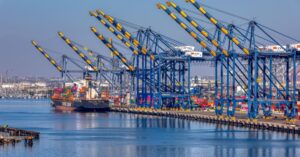A Maersk cargo ship that apparently lost power took down a bridge spanning Baltimore’s harbor early on March 26, with six people unaccounted for as of late in the day. The disaster closed the busy port, causing a ripple effect across already challenged supply chains.
With access to the terminals closed for an unknown length of time, about 10,000 TEU in daily volume will have to go somewhere. According to an analysis by shipping industry expert Lars Jensen, the port of Baltimore handled 265,000 TEU in Q4. The immediate concern becomes, according to Jensen, how rail and trucking will be able to divert that many containers to other East Coast ports for processing – and which ones.
All Eyes On Ocean Freight Rates As Renewal Deadlines Approach
Shippers are keeping a close watch on daily spot container rates while looking to renew ocean freight contracts. Meanwhile, a House bill calling for increased scrutiny of alleged Chinese influence on cargo rates received overwhelming support. As Houthi activity heats up in the Red Sea, and potential East/Gulf Coast port disruption looms, risk assessments are needed to determine which end of the country to book cargo into. Here’s a breakdown of some of the top industry stories making headlines.
Shippers Playing Wait-And-See on Carrier Contracts
It’s a waiting game for shippers looking to renew ocean freight contracts. Eagle eyes are watching falling spot rates, and benchmark deals struck by major shippers. The spread between spot and contract rates is now about $2,500 per TEU, the largest it’s been since September 2021. A supply chain consultant told Sourcing Journal he doesn’t expect the Red Sea issue to have a material impact on contract rates. Some shippers are even opting for three-month contracts, in order to not miss out on lower rates later in the year.
Ocean Freight Rates Continue to Fall
Daily spot rates for ocean freight are 25% to 30% lower than their peak in January and February, as traffic routing around the Red Sea has stabilized and demand is lower, according to the Freightos for the week of March 18. With rates about 2.5 times higher than 2019 levels, analysts believe they can fall further. Meanwhile, air cargo volumes out of India and Dubai are increasing, partly due to Red Sea-related diversion, and outbound air freight from China is on the rise as well.
Legislation Calls for Investigation of Chinese Influence on Container Freight Market
A bill that overwhelmingly passed the U.S. House of Representatives on March 21 is intended to protect U.S. ports, shippers, and consumers from alleged malign influence by the Chinese Communist Party (CCP). It would give the Federal Maritime Commission (FMC) greater authority to crack down on what one co-sponsor called “China’s unfair shipping practices.” The aim is to combat alleged container freight market manipulation by the Shanghai Shipping Exchange (SSE), in concert with the People’s Republic of China, to the benefit of Chinese carriers. The SSE’s Shanghai Containerized Freight Index aggregates spot market data used to set trans-Pacific container rates. The legislation would also:
- Prohibit ports and terminal operators from using Logink, a logistics information system operated by the PRC.
- Establish a National Seaport Advisory Committee, made up of representatives from port authorities and terminal operators, and a National Ocean Carrier Advisory Committee made up of carriers, freight forwarders and NVOCCs.
- Allow for greater FMC scrutiny of carriers operated by so-called “non-market economies” including China, Russia, North Vietnam and a number of former Soviet republics.
FedEx, MSC Face Up to $11 Million in Fines in FMC Charges
FedEx Transport (FTN), the freight forwarding and customs brokerage division of the carrier, faces up to $11 million in fines from the FMC in connection with a complaint alleging unfair charging practices. According to the complaint, AirBoss Defense Group (ADG) alleges that FTN and terminal operator Total Terminals International (TTI) failed to disclose information on detention and demurrage charges at TTI’s terminal in Long Beach in November 2021. ADG’s inbound cargo was refused customs clearance because McWilliams Collective, acting on behalf of FTN, allegedly lacked a U.S. tariff or bond. As a result, the goods were eventually destroyed and ADG got an $11.3 million D&D bill. ADG has also sued McWilliams Collective in California.
DOT’s FLOW Program Publishing Real-Time Supply Chain Data
The Department of Transportation’s Freight Logistics Optimizations Works (FLOW) initiative is now publishing real-time data on the movement of goods to and from inland freight hubs. The public-private partnership created in 2022 includes major retail and logistics partners such as Walmart, Target, Nike, Home Depot, FedEx, Union Pacific, and DHL. “We are getting a look at actual demand,” said Andrew Petrisin, advisor for multimodal freight for the Department of Transportation. “By aggregating purchase orders from our shippers 40 days out and importer partners, as well as booking information from our ocean carrier partners 60 days out on a daily basis, the broader membership can see and understand aggregate future demand.”
Major Carriers Resume China to East Coast Lanes
Maersk is resuming a lane from China to East and Gulf ports (requires subscription) that had been suspended in 2023 due to lower volumes, beginning in late April. The change comes as ocean freight rates between Asia and the East Coast have nearly doubled since mid-December due to Red Sea diversion, although down from a January peak. THE Alliance members Yang Ming and Ocean Network Express will also restart Asia to East Coast service (requires subscription) in May.
Amid Volatility, You Need a Partner Who Can Assess and Deliver
With so much volatility in ocean freight worldwide, constant vigilance is required to properly assess and react to market signals as shippers make plans for the balance of the year. Containerized freight import volume from Asia, to pick just one metric, was up nearly 40% year-over-year in February. Combined with retailers projecting 7.8% growth in exports in the first half of 2024, an upward revision from 5.3% just a month earlier, it’s a sign that rates will turn north shortly.
For more than 25 years, shippers across industries have trusted COGISTICS Transportation to provide a complete logistics solution offering reliable, efficient service across land, sea, and air. From our expedited freight service to our holistic, cloud-based technology platform, every aspect of COGISTICS Transportation is fine-tuned to deliver consistent excellence and performance. Contact us today to learn more.




